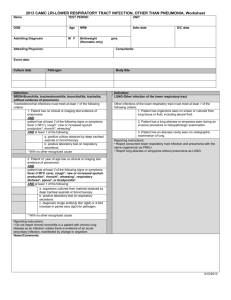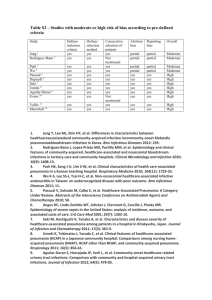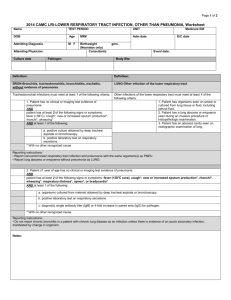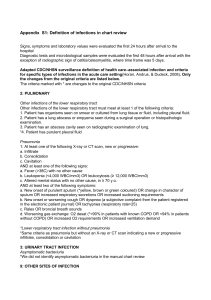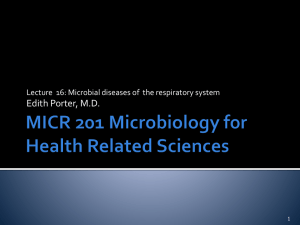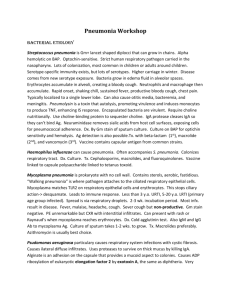Respiratory Tract Infections
advertisement
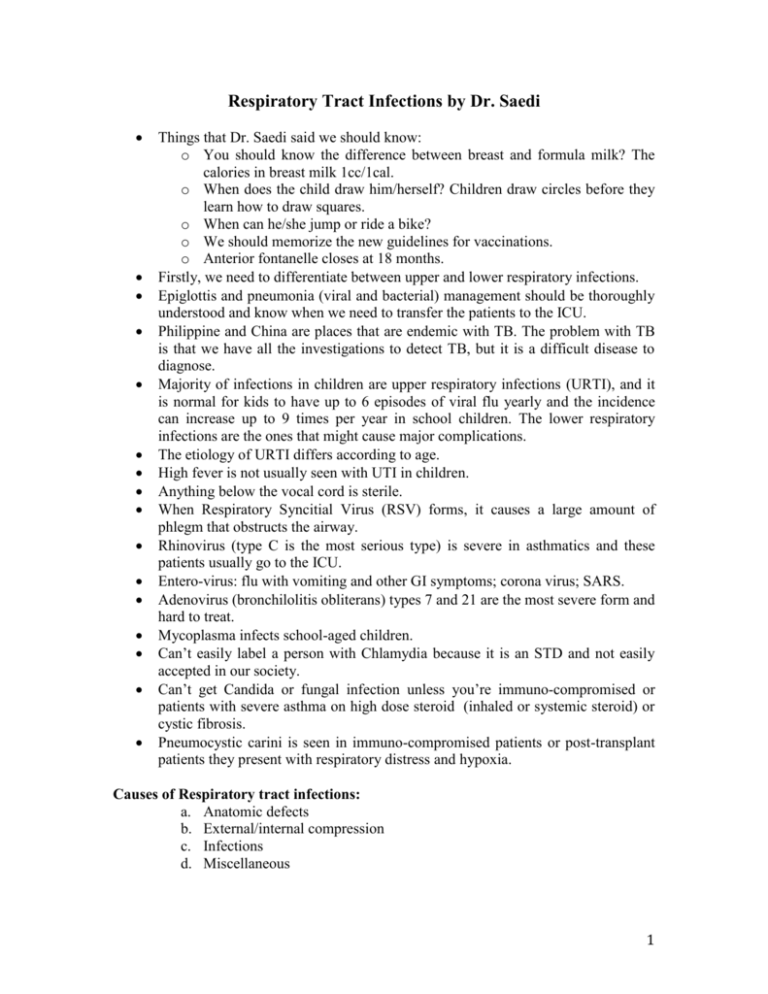
Respiratory Tract Infections by Dr. Saedi Things that Dr. Saedi said we should know: o You should know the difference between breast and formula milk? The calories in breast milk 1cc/1cal. o When does the child draw him/herself? Children draw circles before they learn how to draw squares. o When can he/she jump or ride a bike? o We should memorize the new guidelines for vaccinations. o Anterior fontanelle closes at 18 months. Firstly, we need to differentiate between upper and lower respiratory infections. Epiglottis and pneumonia (viral and bacterial) management should be thoroughly understood and know when we need to transfer the patients to the ICU. Philippine and China are places that are endemic with TB. The problem with TB is that we have all the investigations to detect TB, but it is a difficult disease to diagnose. Majority of infections in children are upper respiratory infections (URTI), and it is normal for kids to have up to 6 episodes of viral flu yearly and the incidence can increase up to 9 times per year in school children. The lower respiratory infections are the ones that might cause major complications. The etiology of URTI differs according to age. High fever is not usually seen with UTI in children. Anything below the vocal cord is sterile. When Respiratory Syncitial Virus (RSV) forms, it causes a large amount of phlegm that obstructs the airway. Rhinovirus (type C is the most serious type) is severe in asthmatics and these patients usually go to the ICU. Entero-virus: flu with vomiting and other GI symptoms; corona virus; SARS. Adenovirus (bronchilolitis obliterans) types 7 and 21 are the most severe form and hard to treat. Mycoplasma infects school-aged children. Can’t easily label a person with Chlamydia because it is an STD and not easily accepted in our society. Can’t get Candida or fungal infection unless you’re immuno-compromised or patients with severe asthma on high dose steroid (inhaled or systemic steroid) or cystic fibrosis. Pneumocystic carini is seen in immuno-compromised patients or post-transplant patients they present with respiratory distress and hypoxia. Causes of Respiratory tract infections: a. Anatomic defects b. External/internal compression c. Infections d. Miscellaneous 1 Acute epiglotitis It is important for all pediatricians to diagnose and manage epiglotitis because pediatricians will see these patients before ENT and it’s a medical emergency. Was common before Hib vaccine unless caused by atypical organisms, it results in severe infections with airway compromise and most patients who have acquired the infection are seen with tracheostomy scars. It is caused by H.influenza and once we diagnose patient with epiglotitis (by swab and laryngoscope) transfer immediately to the ICU and intubate. Clinical picture: 1. Voice is not hoarse but speech is MUFFLED. 2. Cough is not croupy. 3. Patient is usually leaning forward, opening the mouth and maybe drooling. 4. Gasping for air. Note: You don’t always need to do x-ray, but if you do, make sure there is a lateral view to show the thumb sign. Treatment: Mainstay is to secure the airway. Elective intubation: the tube should be small because the area is edematous and to avoid injury. Extubation should be done when the patient is: 1- Afebrile. 2- Swallowing comfortably. 3- Air leak in tube. Put the patient in a dark room and monitor with a pulse oximetry, insert a nasopharyngeal tube use a small size (0.5 mm smaller then the usual recommended size to avoid injury), which will show an air leak (a good sign for healing) rather than oral tube and intubate in the ER whenever you have an appropriate settings. Antibiotics 2nd or 3rd generation cephalosporins for 7-10 days THERE IS NO ROLE FOR STERIODS IN ACUTE EPIGLOTITIS! Croup (laryngotracheobronchitis) 1. Para influenza type 1 is the most common type while type 2 and type 3 are less common. RSV, adenovirus or influenza viruses can also cause it. 2. Mycoplasma pneumonia is the only bacteria that cause croup, especially in winter. 3. Starts as rhinorrhea and might progress to respiratory failure presenting as stridor and asynchronous thoraco-abdominal breathing. 4. Mild disease lasts 7-14 days unlike epiglottitis. 5. Age group affected 6 months - 3 years. 6. Less than 1% (one third of patients) requires intubation so you can reassure the parents. 7. X–ray not always done but shows a rat-tail sign indicating subglottic stenosis (steeple sign). 8. Treatment: 2 a. Must give steroids, unlike epiglotitis. Moist air is used as supportive therapy by causing vasodilation. b. No role for antibiotics c. Give Oxygen if patient is hypoxic: (<92%) by pulse oximetry. It is important to maintain saturation above 92 because it drops by 3% during sleep. d. Any route of steroid can be given (IV, oral, IM). Place IM steroid (0.6 mg dexamethasone) lateral upper part of the thigh to avoid atrophy of the buttocks and possible limping. e. Racemic Epinephrine (bronchodilator) can be used in the treatment but causes rebound phenomenon; therefore, must monitor patients for two hours after giving the drug and before discharge. Pneumonia Streptococcus pneumoniae is the commonest cause of community-acquired pneumonia in all age groups. Staphylococcus aureus is common in age group less than 1. Group B strep is common in newborns. TB can happen at any age. Hib can affect any age group but is a rare cause. In immunocompromised patients, any organism can be the cause. Viral pneumonia treatment is supportive unless it worsens, you ventilate. Viral pneumonia is hard to be differentiated from bacterial pneumonia. Most common cause of viral LRTI is RSV. Bronchiolitis is a clinical diagnosis by history and examination. It is usually caused by a viral infection most commonly RSV. It commonly affects the small and large airways. 90% of children have it by their first birthday. Presentation: Fever, wheezing, nasal discharge, and dry cough characterize seasonal viral illness. On examination, there are fine respiratory crackles and high pitch expiratory wheeze. In SA all year long because they travel a lot, but peak is February and January, while UAE and Bahrain peaks in March. Australia, News Zeeland, Japan in other months Diagnosis: Viral panel from nasopharyngeal aspirate showing RSV is the most important diagnostic tool. Chest x-ray not specific for RSV but if done shows: 1- air trapping; therefore, you do not need to do it to every patient with RSV. 2- Consolidation is due to secondary bacterial infection, 3- Atelactasis is due to excess mucous plugging leading to V/Q mismatch and CO2 retention. Chest x-ray is not needed unless patient was in respiratory distress. 3 In bronchiolitis, hyper-inflated lungs on the chest x-ray and a dirty appearance but in pneumonia lungs are not hyper-inflated. If we give ventolin it increases the blood supply by causing vasodilatation and worsens the hypoxia by increasing the mismatch. If you do bronchoscopy you will suck large amounts of phlegm. Complications 1. Atelactasis (commonest) 2. Fatigue 3. Respiratory failure 4. Bronchiolitis obliterans especially with adenvirus 5. Myocarditis 6. Pericardial effusion 7. Supraventricular tachycardia Risk factor for severity: 1. Pre-maturity. 2. Low birth weight. 3. Age <6-12 weeks. 4. Chronic pulmonary disease. 5. Hemodynamically significant cardiac disease. 6. Immunodeficiency. 7. Neurological disease. 8. Anatomical defect of airway. Environmental risk factors: 1. Older siblings carrying infections from school. 2. Concurrent birth siblings. 3. Native American heritage. 4. Passive smokers. 5. Household crowding. 6. Childcare attendance. 7. High altitude (Abha, Tiaf). Treatment: Oxygen, bronchodilators and physiotherapy but no suction. If the patient has respiratory distress or has social reasons (too many kids at home, or lives far away from hospital), or dehydrated patients, or underlying disease then the patient should be admitted. IV fluid. 30% respond to ventoline; steroid not recommended. Ribavirin (teratogenic). According to “BMJ”, there is no clear evidence that this drug will help patient get better so it is not recommended. Racemic epinephrine is a mixture of epinephrine and a sympathomimetic bronchodilator that is delivered by aerosol and the patient should be assessed after administration of the drug. 4 Chest physiotherapy is not really needed but you can do it. Endemic months: September, November, December, and January. Think of prophylaxis with Pallivizumab 15mg/kg every month for 5 months, if he doesn’t get the infection. If he gets the infection during the 5 months, he will acquire immunity and no need for the drug anymore. Serious infection does not happen with RSV except if the patient becomes septic then we should start antibiotics. Mycoplasma pneumonia Differential diagnosis of adult chronic cough and sore throat. CXR not specific but suspect M.pneumonia if more than 5 years old (school age). Can be unilateral or bilateral and 20% can have pleural effusion WBC is normal or slightly high; unlike in pneumococcal pneumonia where the WBC is highly elevated and might reach 23,000. Cold agglutinin test is positive. Treatment: Macrolides (azythromycin-erythromycin) be cautious when giving it, it can cause deafness, and in cardiac disease may lead to death so it is a contraindication then. Erythromycin is the safest. Bacterial pneumonia S/S: fever, chills, rigors, cough, chest and abdominal pain. Younger patients have less specific signs and symptoms. Dehydration and irritation of the colon, causing diarrhea are symptoms in a children less than 5 years that you should not ignore. Lobar pneumonia (hypo or hyper natremic dehydration due to the diarrhea) usually has very bad pleuritic pain. Infection during neonatal period: could be listeria monocytogenes (cattle organism). It is an extremely rare gram –ve bacilli treated with ampicillin. After neonatal age group, strep pneumonia, staph and Hib are more common. Carries of Strep pneumonia must take prophylaxis by ciprofloxacin (600 mg) after coming back from Hajj. Investigations: Most cultures don’t show growth because patients abuse antibiotics; therefore, start patients on empirical antibiotics. Blood culture yield on 30%. WBC 30-35,000. Sputum does not yield high results unlike in adults. Pulse oximetry is enough in children, while ABG is not needed. Treatment: Start empirical therapy Oxygen (it is considered as a drug so must specify the correct dose). Augmentin: if less than 5 years and not severe or if more than 5 years of age. 5 Indication for transfer to ICU: 1. Pneumonia is so severe and child developing respiratory failure requiring assisted ventilation. 2. Pneumonia complicated by sepsis (high WBC and low BP). 3. Failure to maintain Oxygen saturation above 92 or if PO2 is less than 60%. 4. Shock. 5. Elevated respiratory rate is an indication for pneumonia. 6. Paradoxical breathing. 7. Recurrent apnea. Indications for hospital admission: 1. Significant tachycardia first parameter to change is respiratory rate. 2. Prolonged capillary refilling. 3. Chronic lung disease with pneumonia. 4. Severe disease in older children. 5. RR> 50 (normal respiratory rate in neonates is 50). 6. Dehydration. 7. Not feeding. 8. Difficulty breathing 9. Intermittent apnea. Note: pneumonia is considered severe if patient was tachycardic, O2 saturation is less than 92%, RR is more than 50 breaths/min. Complications: 1. Para-pneumonic effusion With the most causative organism, being staph, Hib, and strep pneumonia. If transudate, it is less likely to be infection, exudate is infection. Aspirate is taken to lab and shows decreased glucose and increase protein. It is a slow healing complication. No need to drain it unless patient is in distress. Thoracocentesis is usually diagnostic and not always therapeutically needed. 2. Empyema: WBC>15,000. Protein> 3g/day. pH<7.2. We also have to order LDH and take a culture from the pleural aspirate, recovery is very slow. Management: ABx and drainage (only if patient is distressed). Therefore, thoracocentesis is used for diagnosis and treatment and as mentioned before treatment incase of distressed patient. Staph. Areus infections can have thin walled cavities (pnematoceles) with a 40% risk of progressing into pneumothorax so these patients should not fly or dive. 3. Lung abscess: usually occurs in the posterior lobe. Treatment is penicillin G, clindamycin (lung or oral anaerobes), or flaygl (GI anaerobes) 6 Predisposing factors for necrotizing pneumonia: 1. Congenital lung cysts 2. Sequestration 3. Neurological disease 4. Broncheactasis 5. Immunodeficiency 6. Certain pneumococcal strain 7. Staph aureus with 8. Septicemia 9. Mets infection with osteoarthritis, osteomyelitis 10. Hemolytic uremic syndrome Tuberculosis Atypical patients don’t rule out TB, example 10 year old girl came with uveitis PPD was done showing an induration of 23 mm and her mother and father had an induration of 56mm and 32mm respectively. Children infected with TB always have an adult (index case). Somalia, China, and Philippines have MDR (INH resistance). Children don’t require isolation because they get the primary infection, which is usually non-infective. Adults become non-infective 2 weeks after the initiation of Anti-TB. Culture takes 4-6 weeks, now PCR shows results 2 hours. Mostly less than 4 year olds are infected. Clinical features: Insidious onset 1. Weight loss. 2. Anorexia. 3. On and off fever. 4. Hepato-splenomegaly. 5. Headache (meningitis). 6. Abdominal pain. 7. Dysphagia due to lymph node compression. 8. Children with TB meningitis ongoing TB within community. Note: Always go for induration not erythema in PPD. PPD is –ve in 30% if the cases. Management: Diagnosis Z-N strain should be done in 24 hours showing acid-fast bacilli. If PPD is negative, repeat in two weeks. BCG vaccine in children is effective against preventing TB meningitis, miliary, and severe TB. Some people develop BCGitis at the site of injection because they have defective inflammation (IL-2 deficiency). If you can diagnose by chest x-ray, treat as pneumonia. If there is no improvement, widen your differential. 7 Medication Isoniazid is safer for latent TB. Complications arise within the first year always check patients LFT associated with most anti-TB drugs. If a child had contact with a positive T.B case: o If PPD was negative, treat with INH (if he/she was less than 4 years or has HIV). We repeat the PPD after 3 months. o If PPD was positive, do chest x-ray, if the CXR was negative treat prophylactically with INH for 6-9 months, if the CXR was positive treat as TB. Indications for steroid: 1. TB meningitis and increased ICP due to brain stem inflammation and increase in head circumference. 2. Endobronchial (TB collapse or airway trapping). 3. Miliary TB, pericarditis, pleural effusion, peritonitis. 8
